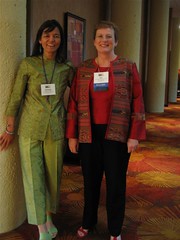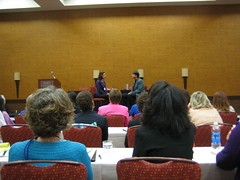An ADD Thing Happened On The Way To The NSGCD Conference
Recently I received a call from a young woman looking for an organizer for her parents who were hoarders. I took the job and it turned out to be a good fit. When I realized that I had been referred by two other organizers (who were already booked), I asked the daughter where she had found them. Like most of the younger generation she had done an Internet search and had come across the database of the National Study Group on Chronic Disorganization, the NSGCD, an organization I had joined at its inception nearly ten years ago. I called them up to find out why I wasn't listed in the database.
"Your membership hasn't been paid up since 2003", I was told.
"What?" I was stunned. Could I seriously be so disorganized that I didn't even realize I was no longer a member of an organization that was so vital to my development as a professional organizer? In fact I had, only a few weeks before been a speaker on a panel recommending the educational benefits of the organization. True, I did belong to four other organizations that required yearly dues and it was easy to lose track, but the irony of this particular oversight kept coming up in my mind, rubber stamped with the label ADD (Attention Deficit Disorder).
No one in the organization had once questioned my status, despite my having attended the annual conference every year professing to be a long-standing member. This I attributed to my ability to project such confidence that people assumed I knew what I was doing. After all I hung out with the upper echelon of leadership. But maybe that was because I was raised to rub elbows with royalty, I mused, thinking of my Thai grandmother. (Though, of course, one is not actually allowed to touch Thai royalty.)
When the NSGCD was still a special interest group within the National Association of Professional Organizers (NAPO), I was rooming with Judith Kohlberg at the annual conference. She had founded the NSGCD to talk about these interesting clients.
"I'm the rebel in the outfit," she informed me.
At the time, organizers were intent on setting up systems and training clients to use them. Judith was suggesting that disorganized clients see the world differently and needed different systems they would be more inclined to use. She coined the term chronic disorganization to describe clients who did not claim a medical diagnosis.
This alternative approach appealed to me. I, too, would be a rebel organizer and learn from my clients. A few years later the study group was formalized into its own entity holding an annual conference to train organizers on how to work with different brain styles. In the meantime time another of my leadership angels, Denslow Brown (originally introduced to me by a mutual friend), had undertaken in-depth testing to confirm that she did indeed have ADD. She began to give workshops on what systems best worked with this learning style.
This additional information was tricky. When I first learned about ADD, I recognized that I could easily claim many of the symptoms, but as soon as l embraced the diagnosis it just allowed me to fall apart altogether. Better to continue to perform as expected and take the heat for the usual mistakes that came from getting distracted. It was only recently that I realized that I simply performed better under a certain amount of stress because it focused my mind. And the advantage of ADD is that this hyper-focus will deliver. The rest of the time I was held together by coping techniques devised from experience. Having a roommate at conference, for instance, helped tremendously.
Kim Anker-Paddon, my conference roommate, for the last several years, always booked the hotel room long in advance. For this I was immensely grateful. It was hard enough for me to book my flight since dates unnerved me, due to frequent crossing of the international dateline. I had more than once had to rebook flights because I hadn't calculated correctly when I was supposed to be somewhere.
Kim joined NAPO when I was program chair of our local chapter meetings. At the time I was convinced that professional organizers took themselves far too seriously especially regarding our image as business people, thus I was intent on imbuing every meeting with a certain level of theatrics, which usually required that I design a costume for the event pertaining to the topic of the evening. Thus when we had a speaker on finances I made a vest covered with coins and wore a bowler hat in the tradition of British bankers. And when the topic was marketing I made a headpiece with letters cut from blue cardboard so that on one side of my head the letters WWW appeared and on the other side the letters COM. (Having a website was very cutting edge at the time.) My colleagues loved this little bit of entertainment. They were a very forgiving audience and laughed at all my jokes; this endeared them to me for life.
Kim was without a roommate because she was afraid of keeping a colleague awake with her snoring, but I persuaded her that that wouldn't be a problem since I was hard of hearing. Besides we shared a common perspective, having lived outside of the US as children, and we would need this support when traveling to the middle of the country. This time it was Texas, but luckily Austin, Texas, which I had heard more resembled a suburb of San Francisco and bore very little relation to the home state of the Bush family.
When I told Kim how I'd discovered I had failed to pay my membership since 2003 and would have to fess up to my ADD even though it hadn't really been a problem before, she explained that ADD was a continuum. Some were worse off than others. She was well versed on the subject as she had a brother and a daughter with ADD and had certified as an ADD specialist. That was another thing I had neglected to do, but now that I had moved into performance mode, I was going to jump in with both feet and do two levels of certification in the space of a few weeks. This would get me listed higher up on the database.
"You'll want to do the certificate on hoarding too", Kim told me when I announced my plans. It was being offered for the first time. I signed up for two exams because you couldn't get the hoarding certificate without first getting one on chronic disorganization. I had long ago read the books for the first so prior to conference managed to read three and two halves of the five required books for the second. I was confident that I would perform my way through both exams if I just managed to get there.
An hour before the exam I got dressed and sat looking apprehensively at the sun setting over our splendid view of Austin from our hotel room, while Kim did some last minute review. Getting places on time made me nervous. The previous month I had, as usual, been perfectly punctual to a client's house only to find that I was at the wrong house. I had mixed up addresses with another new client. (Fortunately the second client was used to disorganization and didn't give it a second thought when I showed up half an hour later.)
Not many organizers purposely seek out what we loosely call the CD population—the chronically disorganized. Organizers, on the whole, liked to see results and working with the CD population took patience as far as visible results were concerned, especially with hoarders. Often my colleagues were puzzled by those afflicted with chronic disorganization, but even more so by their ambiguity about getting things done. As one organizer put it, "They are so illogical."
"But that's why they are so interesting," Kim said when I relayed this sentiment. Exactly.
My hyper organized colleagues were more ambitious than I was, eventually gravitating towards mega projects involving moving large households, or estate jobs (liquidating the households of dead people), or setting up complex business filing systems, or various event-planning jobs with non-negotiable deadlines. These jobs paid better, filled up a workweek nicely and tended to follow schedules according to carefully laid out plans. Plus they had less chance of a cancellation.
The NSGCD attracted organizers who were process oriented as well as results oriented. Plenty had relatives with ADD or hoarding issues (or were secretly disorganized themselves). Psych majors turned professional organizers and a handful of psychologists, collaborating with organizers, rounded out the group. Mental health specialists were often engaged as speakers.
Not too long ago a handful of psychologist discovered hoarders and left the sanctity of their offices to enter the "field" to categorize and label extreme cases for which they then devised "treatments". We at the NSGCD eagerly listened and watched as the research evolved. These clinicians borrowed liberally from our organizing techniques, then proceeded to apply cognitive therapy techniques as they talked to their subjects about their stuff. They wrote papers and entered a new diagnosis in the DSM, the guide to pathologizing the known universe of the human experience.
I happily absorbed all the new information and just as happily ignored it when working with clients. It was not my responsibility to diagnose clients and the corresponding treatments only added to my brain clutter; I feared it would impair my ability to listen, not only to my clients, but my intuition. (If a client volunteered a diagnosis that was different. My learning could then provide that vocabulary too and we could discuss it openly).
One psychologist, on a panel at conference, complained that our lack of training could make clients worse. With OCD (Obsessive Compulsive Disorder) cases, for instance, when we enabled their perfectionist compulsions. But we were often the first responders for these clients; and if they didn't like what we were doing out we'd go and along with us a possibility of improvement.
I did have an OCD client, but once she came to trust me I rather enjoyed torturing her by theatrically destroying valueless things she wanted to hang onto. After I stomped down a pile of empty Kleenex boxes, she asked why I had to smash them (which would prevent her from retrieving them once put in the recycle bin). "I have to have some fun on this job," I told her. I didn't get a laugh, but I did get acceptance.
My clients were not extreme hardcore cases; they just wanted to get organized. Many kept me coming back because I was an adept conversationalist able to both field and introduce topics to pique their interest. Like them, I was in search of the larger meaning of everything (no topic was taboo from politics to God). And somehow, as we talked, whether it was a little or a lot, while working through their stuff, the larger meaning of everything also managed to prioritize and clear a room. (It helped that I was a speed paper sorter and adept at visualizing space. Plus I had figured out how to set-up my environment to save my butt rather than sabotage it.)
I put a lot of stock in this conversational glue. It generated energy, put the mundane tasks in perspective, side stepped a lot of emotional issues and bonded us as a team. But it was not something I could teach in a workshop. Nor could it be formalized as a treatment. And that is the difference between an entrepreneur and a clinical practitioner. We get to try anything we think will work; we can set boundaries wherever we see fit and because we are paid directly by clients we are driven to learn—quickly. By definition we defy any consistency of standards. It is our hard won experience that develops us and we start with incredibly diverse abilities and skill sets.
Just putting all these organizers in a room created a rapid-fire exchange of ideas, opinionated personal dynamics, a myriad of brain styles coupled with a high level of confidence and a broad spectrum of belief systems. If there was anything we were willing to agree on it was that all our meetings be run on time. It was downright intimidating—which just brought out the best in me.
Kim and I got up to take our exam(s). She asked my fashion advice.
"Which shoes should I wear red or black?"
We would both pass easily and spend the rest of conference heatedly examining all the new information, each speaker and what it all meant. We stretched each other.
"Curtains opened or closed?" she asked when she returned to the room to find the drapes partially closed on one side. (I was blocking neon light from a building.)
"Is that the only option?" I teased. "What if the window was actually only that big?
"Oh all right," she conceded.
Labels: ADD, business, continuing education, disorganization, livelihood, organizing






